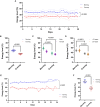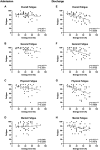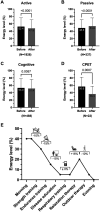Design and validation of an energy level diary for fatigue management in patients with post-COVID syndrome
- PMID: 40761505
- PMCID: PMC12318978
- DOI: 10.3389/fresc.2025.1633466
Design and validation of an energy level diary for fatigue management in patients with post-COVID syndrome
Abstract
Background: Post-COVID syndrome (PCS) is a frequent condition with an incidence of 7.8-10.6 per 100 unvaccinated and 3.5-5.3 events per 100 vaccinated persons. Cognitive and motor fatigue are common clinical manifestations, limiting patients' occupational, educational, and social activities severely.
Objective: This study aimed to develop a diary to keep record of daily changes in energy levels of patients with PCS to adapt their rehabilitation program.
Material and methods: We conducted a prospective observational study at two German rehabilitation centers in a codesign approach with repeated feedback loops. Daily energy changes were analyzed and validated using the Multidimensional Fatigue Inventory-20 (MFI-20).
Results: The final diary revealed that morning and evening energy levels of patients with PCS differed significantly, with 49.6 ± 18.6% and 33.4 ± 19.7%, respectively (p ≤ 0.0001, on admission). Energy levels decreased by ∼5% with active therapy and increased by ∼5% with passive therapy (p < 0.0001). A comparison with MFI-20 at discharge showed good negative correlation (r = -0.5358, p < 0.0001), and patient interviews revealed that most patients (N = 19; 95%) rated the diary as "useful for self-reflection" and "helpful tool to learn the process of pacing."
Discussion/conclusion: This diary is a valid and user-friendly tool to detect and control the effects of daily therapy during the rehabilitation of patients with PCS. It will facilitate individual planning and adaptation of therapies in PCS and other fatigue groups and may help to implement an effective relation of exercise load to load capacity (pacing) for optimal coping with the disease and an improved handling of daily activities in patients' lives.
Clinical trial registration: Clinicaltrials.gov, identifier (NCT06883500).
Keywords: chronic fatigue syndrome; diary approach; neurorehabiliation; post-COVID syndrome; post-COVID-19.
© 2025 Balke, Garbsch, Cormann, Pape, Mooren and Schmitz.
Conflict of interest statement
The authors declare that the research was conducted in the absence of any commercial or financial relationships that could be construed as a potential conflict of interest. The authors declared that they were an editorial board member of Frontiers, at the time of submission. This had no impact on the peer review process and the final decision.
Figures




References
Associated data
LinkOut - more resources
Full Text Sources
Medical

